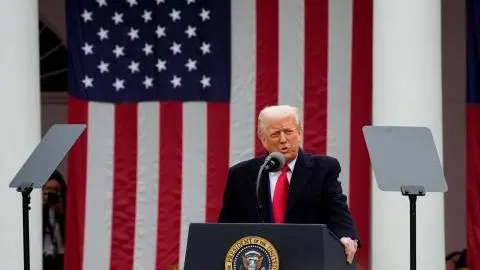FX Daily: Without domestic support, dollar is left a little naked
The 2.5% drop in CNH/JPY overnight probably best encapsulates the fallout from Liberation Day. True to his promise, Donald Trump heavily tariffed those countries he felt responsible for the US goods deficit – most notably Asia. But without providing fresh support measures to the US economy, US equities are being marked sharply lower, helping the yen
USD: Blowback to US growth prospects dominates
The trade-weighted DXY has broken to a new low for the year as investors continue to fear what these new reciprocal tariffs mean for US confidence and activity. This uncertainty has been a key factor driving US equities lower this year and prompting both a dovish re-pricing of the Fed cycle and a weaker dollar. At the time of writing, S&P 500 June index futures are marked to decline around 3% – and this follows a 3% drop in benchmark equity indices across Asia.
Our colleagues have delivered their first views on the announced tariffs here, with an in-depth focus on the US here. An early take on the impact on rates and FX markets can also be found here. At the heart of the story is Donald Trump delivering on his promise to restructure the global trading system. His incentives are clearly laid out in his Executive Order. In reality, the outcome is about as bad as it could be. China tariffs are virtually now at 60%, EU tariffs are at 20% and there's a baseline universal tariff of 10%. Given that these tariffs are being presented at 'discounted rates', there is also the potential for them to be increased in the event of retaliation. The jeopardy of a global trade war remains, and hence we're seeing no relief rally in risk assets on the view that all the bad news is out the way and things are as bad as they can get.
Instead, a pair like CNH/JPY best characterises the mood in FX markets. Asian trading nations are being hit hard with tariffs since the bloc comprises around 60% of the US annual goods deficit. The offshore USD/CNH is sharply higher, although we expect authorities will continue to hold the line in the onshore USD/CNY. Expect an increased focus on the daily PBoC fixings in USD/CNY. Any near-term fixing over 7.20 would trigger another leg lower in Asian FX on the (in our view mistaken) fear that Chinese authorities might tolerate a weaker renminbi after all.
But away from Asia, the dollar is being sold against the big, liquid defensive currencies of the Japanese yen and Swiss franc and, to a lesser degree, the euro. Here, the blowback of US tariffs onto the US domestic economy leaves the dollar naked. US rates continue to be marked lower, and not until we get some surprisingly good news from the US on tax cuts or deregulation may the dollar start to find some support. Indeed, the dollar sell-off could prove a little problematic for Washington in that it had expectations that the dollar would rally on tariffs to provide insulation to the US consumer from higher import prices. And again, this is unlike 2017/18, where a major tax cut went through before tariffs were announced.
With pessimism growing about US domestic demand, expect investors to continue using short USD/JPY positions to express this view. 147.00 is pretty strong support, but heavy US equity losses today could drag it back to the 145 area.
For today's session, look out for the weekly jobs initial claims data and then ISM Services. We should also be on the potential lookout for European retaliation in the services sector, since the US runs a large surplus with Europe in this area.
DXY has nearly retraced 75% of the Trump rally since October. Softer risk assets can drag it towards the 102.00 area today.
Chris Turner
EUR: Rallying, but few reasons to be cheerful
EUR/USD is net around 0.9% higher after the trade announcement. We don't really buy into the story that the worst is out of the way for Europe now. The main buying point for the euro is that it's a big, liquid alternative to the dollar – and that the dollar's troubles (weaker US consumption) are greater than the euro's.
We also think that some medium-term factors are in place in that Washington does want a weaker dollar and that some major investor communities such as FX reserve managers will be looking to reduce the dollar share in their FX portfolio. Also, a lot of the language in Trump's Executive Order is very similar to that used in Stephen Miran's Mar-a-Lago accord paper – espousing the need for a weaker dollar in the longer term.
While a global trade war in theory is a euro-negative, the soft underbelly of the US economy is the dominant factor for EUR/USD right now. A much sharper sell-off in US equities, dragging US rates even lower, adds another nail in the coffin of US exceptionalism and could send EUR/USD over 1.10. Major medium-term resistance sits in the 1.11/12 area. It's hard to call a major break of that unless US activity craters.
For the time being, however, expect EUR/USD to trade off the US equity story, where memories will be stirred of protectionism causing major sell-offs.
Chris Turner
CEE: Trade-open region ready for impact
Yesterday's announcement of US tariffs set off a full risk-off mode for EM currencies and of course the CEE region cannot avoid the hit. Given the trade nature of the shock, HUF and CZK should be the main ones exposed given the open nature of the economy. However, given the dovish National Bank of Poland shift and today's press conference, we believe the PLN may underperform the CZK in this environment.
In the rates space, HUF and PLN have more room for dovish pricing in our view, and we also think that ultimately trade wars for CEE are not as negative as they first appear. However, in the short term, the negative shock is clear for the entire region, and we can discuss further implications later. The CEE's links to global trade and the potential implications are covered in our CEEMEA Outlook Directional Economics published yesterday.
March inflation in Turkey will be released this morning. Any further decline is important news for markets that disinflation is still on track despite the FX sell-off in March. We believe the first impact may only be seen in April inflation, but even so, a better number today may help restore some investor confidence.
In Poland, yesterday's decision by the National Bank of Poland came as no surprise, and rates remained unchanged at 5.75%. However, the statement suggested that sentiment within the council is shifting in a dovish direction and the NBP now sees the possibility of lower inflation than previously expected. We will see the governor's press conference today, however he is likely to remain on the hawkish side. On the other hand, unless we hear some new hawkish arguments, this should be a dovish signal for the market. Moreover, given the weaker economic numbers, we believe that hawkish rhetoric should not affect the markets too much.
Frantisek Taborsky
Download
Download article
3 April 2025
Our take on Trump’s ‘Liberation Day’ tariffs This bundle contains 7 ArticlesThis publication has been prepared by ING solely for information purposes irrespective of a particular user's means, financial situation or investment objectives. The information does not constitute investment recommendation, and nor is it investment, legal or tax advice or an offer or solicitation to purchase or sell any financial instrument. Read more



